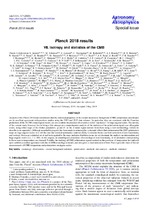| dc.contributor.author | BallardinI, M. | |
| dc.contributor.author | Akrami, Y. | |
| dc.contributor.author | Ashdown, M. | |
| dc.date.accessioned | 2021-02-15T12:05:37Z | |
| dc.date.available | 2021-02-15T12:05:37Z | |
| dc.date.issued | 2020 | |
| dc.identifier.citation | BallardinI, M. et al. (2020). Planck 2018 results VII. Isotropy and statistics of the CMB. Astronomy & Astrophysics, 641, A7 | en_US |
| dc.identifier.issn | 1432-0746 | |
| dc.identifier.uri | https://doi.org/10.1051/0004-6361/201935201 | |
| dc.identifier.uri | http://hdl.handle.net/10566/5931 | |
| dc.description.abstract | Analysis of the Planck 2018 data set indicates that the statistical properties of the cosmic microwave background (CMB) temperature anisotropies are in excellent agreement with previous studies using the 2013 and 2015 data releases. In particular, they are consistent with the Gaussian predictions of the ΛCDM cosmological model, yet also confirm the presence of several so-called “anomalies” on large angular scales. The novelty of the current study, however, lies in being a first attempt at a comprehensive analysis of the statistics of the polarization signal over all angular scales, using either maps of the Stokes parameters, Q and U, or the E-mode signal derived from these using a new methodology (which we describe in an appendix). Although remarkable progress has been made in reducing the systematic effects that contaminated the 2015 polarization maps on large angular scales, it is still the case that residual systematics (and our ability to simulate them) can limit some tests of non-Gaussianity and isotropy. | en_US |
| dc.language.iso | en | en_US |
| dc.publisher | EDP Sciences | en_US |
| dc.subject | Cosmology: observations | en_US |
| dc.subject | Cosmic background radiation | en_US |
| dc.subject | Polarization | en_US |
| dc.subject | Methods: data analysis | en_US |
| dc.subject | Methods: statistical | en_US |
| dc.title | Planck 2018 results VII. Isotropy and statistics of the CMB | en_US |
| dc.type | Article | en_US |

